

The PISA 2012 Results Infographic. Other Infographics How OECD countries scored at the PISA’s 2012 results?

How does your country compare for reading, maths, and science? More than 510,000 students took part in this latest PISA survey, representing about 28 million 15-year-olds globally. These PISA results reveal what is possible in education by showing what students in the highest-performing and most rapidly improving education systems can do. Formative assessment. על השיטה להערכת היצירתיות בכיתה. How to Evaluate a Training Program Infographic. Other Infographics If you deliver training for your team or your organization, then you probably know how important it is to measure its effectiveness.

After all, you don’t want to spend time or money on training that doesn’t provide a good return. This is where Kirkpatrick’s Four-Level Training Evaluation Model can help you objectively analyze the effectiveness and impact of your training, so that you can improve it in the future. The How to Evaluate a Training Program Infographic presents Donald Kirkpatrick’s model . The model has 4 levels of evaluation and is a solid base to begin: Reaction: Did learners like the training?
השפעות של משוב על כתיבה שיתופית בסביבה מקוונת. How To Determine A Student's Prior Knowledge. מאמרים / משוב שוטף מקדם למידה טובה - יורם הרפז. Deeper Learning: Authentic Student Assessment. Is it possible to systemically embed deeper learning outcomes for students?
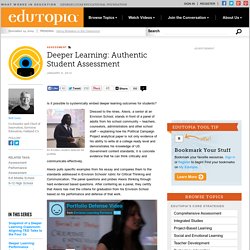
Dressed to the nines, Alexis, a senior at an Envision School, stands in front of a panel of adults from his school community -- teachers, counselors, administrators and other school staff -- explaining how his Political Campaign Project analytical paper is not only evidence of his ability to write at a college ready level and demonstrates his knowledge of US Government content standards, it is concrete evidence that he can think critically and communicate effectively. Alexis pulls specific examples from his essay and compares them to the standards addressed in Envision Schools' rubric for Critical Thinking and Communication.
The panel questions and probes Alexis thinking through hard evidenced based questions. .facebook_1792027712. 21st Century Assessment. Assessment, in the form of examinations, has been a constant feature of education since the 18th Century.
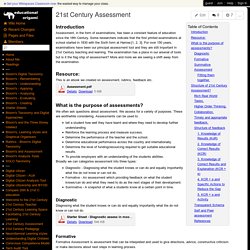
Some researchers indicate that the first printed examinations at school started in 1830 with the Sixth form at Harrow.[1, 2, 3]. For over 150 years, examinations have been our principal assessment tool and they are still important in 21st Century teaching and learning. הבלוג של חנן יניב: הגיגים לקראת הערכה בעולם של “לומדים עצמאיים” Great Polling Tools for Teachers ( No Sign-up Required ) So you are looking for some polling tools to use in your classroom but worried about the privacy issues of your students in regard to the information submitted in the registration process. well you don't have to worry any more I have curate a list of some great web tools to create instant polls without the need for any registration.

Seven Things to Remember About Feedback. Four Free Assessment Apps for 1:1 Classrooms. One-to-one technology can transform a classroom.

When implemented correctly, students are engaged and excited to learn, and teachers can assess their progress in real-time. The amount of technology resources available for educators can be overwhelming. Critical Assessment Ideas from PBL World. I had a great time at the PBL World Conference in so many ways: as a presenter, as a panelist, as a listener, as a collaborator, and even as the subject of art.
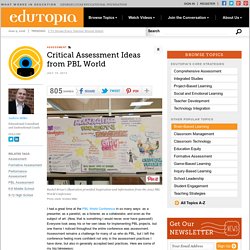
(Now, that is something I would never, ever have guessed!) Everyone took away his or her own ideas for implementing PBL projects, but one theme I noticed throughout the entire conference was assessment. Assessment remains a challenge for many of us who do PBL, but I left the conference feeling more confident not only in the assessment practices I have done, but also in generally accepted best practices. Here are some of my big takeaways: Assess 21st Century Skills There were many "deep-dive" sessions on teaching and assessing 21st century skills, from critical thinking to creativity and innovation.
Assess Process and Product. Yes, You Can Teach and Assess Creativity! A recent blog by Grant Wiggins affirmed what I have long believed about creativity: it is a 21st-century skill we can teach and assess.

Creativity fosters deeper learning, builds confidence and creates a student ready for college and career. However, many teachers don't know how to implement the teaching and assessment of creativity in their classrooms. While we may have the tools to teach and assess content, creativity is another matter, especially if we want to be intentional about teaching it as a 21st-century skill. In a PBL project, some teachers focus on just one skill, while others focus on many. Aligning Assessments with Learning Objectives. When you are creating a course, strive to design with the end in mind.
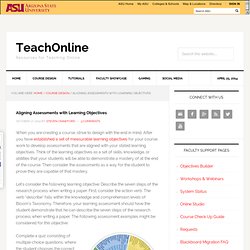
After you have established a set of measurable learning objectives for your course, work to develop assessments that are aligned with your stated learning objectives. Think of the learning objectives as a set of skills, knowledge, or abilities that your students will be able to demonstrate a mastery of at the end of the course. Then consider the assessments as a way for the student to prove they are capable of that mastery. Let’s consider the following learning objective: Describe the seven steps of the research process when writing a paper. First, consider the action verb. Complete a quiz consisting of multiple choice questions, where the student chooses the correct steps. Note that asking the students to write a paper using the seven steps of the research process is not appropriate because this asks the student to perform at a higher level of Bloom’s Taxonomy. הערכה חלופית - DinaRamot-learning. שיטות וגישות בהערכה באמצעים חלופיים קיימת הסכמה (ברנבוים, 2004) בקרב אנשי חינוך על כך שכדי להשיג את יעדי החינוך צריכה להיות הלימה בין שלושת מרכיבי ה-הל"ה - הוראה, למידה הערכה (Biggs, 1999).
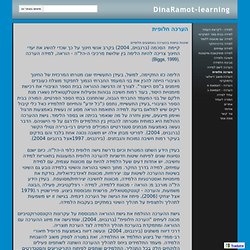
Broadcast Yourself. Authentic Assessment: What You Can Do in 5 minutes, 5 days, 5 months, 5 years . . . The School of the Future (SOF) is a unique place. Its dedication to teaching through real-world tasks, checking on student progress often, and adjusting lessons based on a wide variety of assessments is delivering big dividends with increased student engagement and performance. And although these accomplishments did not occur overnight, we believe that other schools can see similar progress, even if they start small and build slowly.
Below are some creative tips for teachers, administrators, and other educators to help your school begin this journey. Free Resources and Tools for "Authentic" Assessment. The key to innovations in assessment and curriculum planning are trust, transparency, and collaboration -- and providing the professional development and training teachers need to succeed. Credit: Tom LeGoff Note: The School of the Future is part of a network of New York schools that develops and uses its own assessment techniques, referred to as DYOs. The school also uses Tasks on Demand, or unannounced assessments that do not provide supports for the students, in order to measure their learning at regular intervals. Resources On This Page: Multimedia Assessments: Tools for making dynamic audio-and video-based tests. Google Form Video, audio, and images can spark students’ imaginations in ways that text alone sometimes can’t.
Likewise, multimedia often helps students gain a deeper understanding of a question. What is "Authentic" Assessment? Ten Takeaway Tips for Using Authentic Assessment in Your School. The School of the Future's (SOF) mission is to empower each and every student. Teachers accomplish this not only by making their classroom content and instruction engaging but also by making their assessments authentic.
Teachers ask SOF students to demonstrate their comprehension and mastery of the curriculum in ways that are meaningful to them. איך בודקים למידה? 4 Ways to Ensure Students Learn While Creating. Making Sure They Are Learning. Sarah Kaufmann: I think of authentic assessment as my ability to teach each student where they actually are. I'm Sarah Kaufmann. I teach sixth grade humanities at School of the Future. How Do We Know When Students Are Engaged? (Updated 11/2013) Educational author and former teacher, Dr.